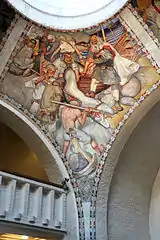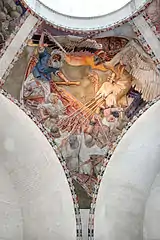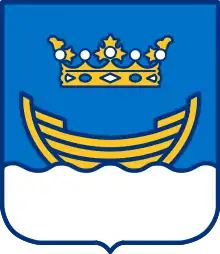National Museum of Finland
The National Museum of Finland (Finnish: Kansallismuseo, Swedish: Nationalmuseum) presents Finnish history from the Stone Age to the present day, through objects and cultural history. The Finnish National Romantic style building is located in central Helsinki and is a part of the Finnish Heritage Agency (until 2018 the National Board of Antiquities) (Finnish: Museovirasto, Swedish: Museiverket), under the Ministry of Culture and Education.[1]
| The National Museum of Finland | |
|---|---|
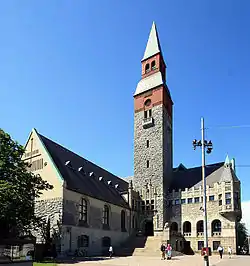 National Museum of Finland | |
 Location within Finland | |
| General information | |
| Classification | Museum |
| Location | Helsinki |
| Address | Mannerheimintie 34 |
| Coordinates | 60.1749°N 24.9294°E |
| Construction started | 1905 |
| Construction stopped | 1910 |
| Opened | 1916 |
| Client | Board of Public Building |
| Owner | Senate Estates |
| Height | tower 58 m |
| Technical details | |
| Floor area | Exhibition area more than 3 100 m² |
| Design and construction | |
| Architect | Gesellius, Lindgren, Saarinen |
| Main contractor | Master Builder August Pettersson and Master Builder Frans Johansson |
Building

The building of the National Museum was designed by the architect company Gesellius, Lindgren, Saarinen. The appearance of the building reflects Finland's medieval churches and castles. The architecture belongs to national romanticism and the interior mainly to art nouveau. The museum was built from 1905 to 1910 and opened to the public in 1916.[2] The museum was named the Finnish National Museum after Finland's independence in 1917. After the last thorough renovation, the Museum was re-opened in July 2000.[3]
- Details of the building
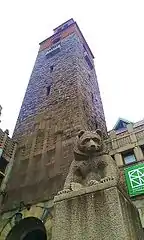 Bear statue by Emil Wikström, 1910
Bear statue by Emil Wikström, 1910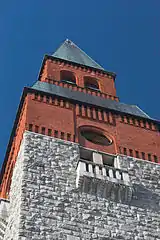 The tower
The tower The other side of the building
The other side of the building Small turret
Small turret Another turret with animal reliefs
Another turret with animal reliefs Front door
Front door Back door
Back door
The museum's entrance hall ceiling has ceiling frescoes in the national epic Kalevala theme, painted by Akseli Gallén-Kallela, which can be seen without an entrance fee. The frescoes, painted in 1928, are based on the frescoes painted by Gallén-Kallela in the Finnish Pavilion of the Paris World Fair in 1900.[3]
Exhibitions
The permanent exhibitions of the National Museum are divided into parts. There are collections of coins, medals, orders and decorations, silver, jewellery and weapons. There is prehistory of Finland, the development of Finnish society and culture from the Middle Ages 12th century to the early 20th century through the Swedish Kingdom Period to the Russian Empire Era, and Finnish folk culture in the 18th and 19th centuries with life in the countryside before the industrialisation among other exhibitions.
The collections also included the Mesa Verde artifacts from the cliff dwellings of Colorado. These were donated to the museum by the Finland Swedish explorer Gustaf Nordenskiöld. They comprised the most-extensive collection of Mesa Verde items outside the United States and one of the largest collections of native Americana outside the American continents.[4] In 2019 it was decided to return a portion of the artifacts to the representatives of the indigenous people of the United States of America, with it agreed for some 600 items to be kept and exhibited.[5][6]
Gas explosion in the Silver Room
On Monday 23 January 2006 there was an explosion accident at the National Museum in the Silver Room, which was caused by methane leaking into a broom cupboard from the drainage through dried floor drain and lit by a spark from the power distribution cabinet in the cleaning closet. There were two possible sources for the methane; a leak from a gas pipe under the nearby Museokatu street, or gas that developed on its own in the sewer. Later, police investigations found the cause to be a gas pipe leak. Most display cases and 49 pieces out of more than 200 silver objects in the museum's Silver Room were damaged in the explosion, although most of them only mildly. Nobody was hurt.[7][8] All objects were successfully repaired the same year. The Silver Room was re-opened to the public in early 2007.
Gallery
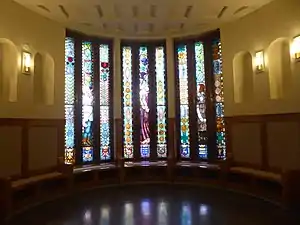 Painted glass
Painted glass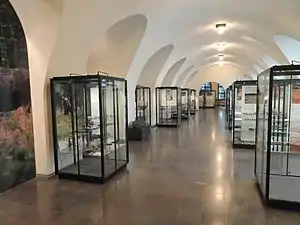 Finnish Stone Age collection
Finnish Stone Age collection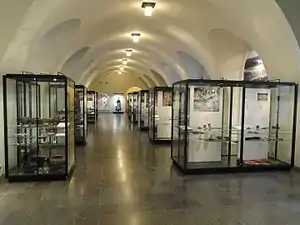 Finnish Bronze or Iron Age collection
Finnish Bronze or Iron Age collection Medieval Finnish Christian art
Medieval Finnish Christian art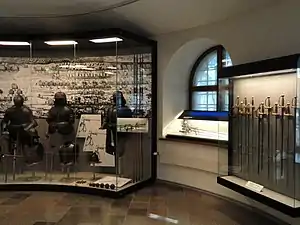 Armor and weapon collection
Armor and weapon collection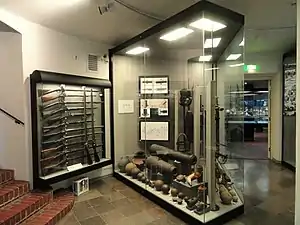 Weapon (and in the back silverware) collection
Weapon (and in the back silverware) collection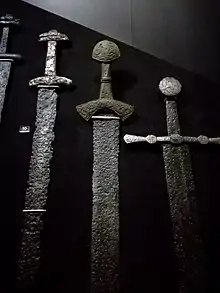
 Tableware
Tableware Various objects
Various objects The Eura Dress of the Eura Matron
The Eura Dress of the Eura Matron Perniö Dress
Perniö Dress Grand furniture and paintings
Grand furniture and paintings Alexander I's seat used at Diet of Porvoo, originally commissioned by Paul I at St. Petersburg in 1797
Alexander I's seat used at Diet of Porvoo, originally commissioned by Paul I at St. Petersburg in 1797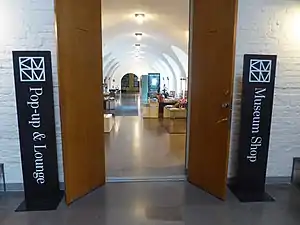 Museum shop and lounge
Museum shop and lounge
See also
- Elk's Head of Huittinen, an eight to nine thousand year old sculpture exhibited at the museum.
Notes
- Finnish National Board of Antiquities web site.
- "Historiaa". Kansallismuseo. Retrieved 29 June 2020.
- "National Museum of Finland". The European Museums Network. Retrieved 29 June 2020.
- FitzGerald, Michael C., "The Majesty of Mesa Verde" in Wall Street Journal, 13 March 2009, p. W12.
- "Mesa Verde". Kansallismuseo. Retrieved 1 July 2020.
- "Finland to repatriate American Indian artefacts to the United States from its national collections". Kansallismuseo. 3 October 2019. Retrieved 1 July 2020.
- "Kansallismuseon räjähdys johtui maakaasusta". Ilta-Sanomat. 17 February 2006. Retrieved 29 June 2020.
- Kokko, Karri (20 March 2009). "Museot elävät monenlaisten vaarojen alaisina". Suomen Kuvalehti. Retrieved 29 June 2020.
External links
| Wikimedia Commons has media related to National Museum of Finland. |
.jpg.webp)


